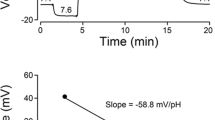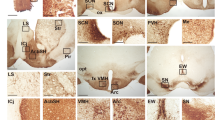Abstract
EXTRACELLULAR Ca ions are required for the secretion of many hormones1. In the adrenal medulla catecholamine secretion evoked by acetylcholine (ACh) is completely blocked by omitting Ca from the medium2,3. The mechanism for Ca entry has been studied in a phaeochromocytoma cell line (PC12) which originated from a rat adrenal medullary tumour4,5. Two alternative ways of Ca entry were considered, voltage-dependent Ca channels and ACh channels. By analysing dopamine secretion4 and radioactive Ca influx5 in various ionic environments it was concluded that more than 80% of the Ca ions enter through the voltage-dependent Ca channels during stimulation by cholinergic agonists. Action potentials mediated by Na6,7 and Ca7 have been demonstrated in primary cultures of rat adrenal chromaffin cells. Furthermore, extracellular recording techniques can detect spontaneous action potentials in these cells. The frequency of these action potentials is modified in a dose-dependent manner by ACh (3×10−7M to 10−4M)7, and the same range of ACh concentrations stimulates adrenaline secretion in the perfused rat adrenal medulla3,8. Thus modulation of action potential frequency by ACh may be a mechanism for controlling the amount of Ca entry. The potential change during a Na action potential may activate voltage-dependent Ca channels, thereby increasing Ca influx. Also, spontaneous action potentials are blocked by 6 µM tetrodotoxin (TTX)7, a specific inhibitor of Na channels9. Therefore, if the Na action potential is involved in secretion, TTX should reduce Ca entry which in turn should decrease catecholamine secretion. We tested this hypothesis in the perfused rat adrenal medulla and report here that TTX decreases a portion of the adrenaline secretion evoked by either high KCl or ACh. Thus, Na action potentials, by facilitating the activation of Ca channels, may be involved in the regulation of adrenaline secretion from adrenal chromaffin cells.
This is a preview of subscription content, access via your institution
Access options
Subscribe to this journal
Receive 51 print issues and online access
$199.00 per year
only $3.90 per issue
Buy this article
- Purchase on Springer Link
- Instant access to full article PDF
Prices may be subject to local taxes which are calculated during checkout
Similar content being viewed by others
References
Douglas, W. W. Br. J. Pharmac. 34, 451–474 (1968).
Douglas, W. W. & Rubin, R. P. J. Physiol., Lond. 159, 40–57 (1961).
Ishikawa, K., Harada, E. & Kanno, T. Jap. J. Physiol. 27, 251–266 (1977).
Ritchie, A. K. J. Physiol., Lond. (in the press).
Stallcup, W. B. J. Physiol., Lond. (in the press).
Biales, B., Dichter, M. & Tischler, A. J. Physiol., Lond. 262, 743–753 (1976).
Brandt, B. L., Hagiwara, S., Kidokoro, Y. & Miyazaki, S. J. Physiol., Lond. 263, 417–439 (1976).
Kimura, K. Scient. Rep. Nayoro Women's Coll. 7, 11–18 (1974).
Narahashi, T., Moore, J. W. & Scott, W. J. gen. Physiol. 47, 965–974 (1974).
Nagatsu, T. in Biochemistry of Catecholamines, 230–234 (University Park Press, Baltimore, 1973).
Shore, P. A. & Olin, J. S. J. Pharmac. exp. Ther. 122, 295–300 (1958).
Hagiwara, S. in Advances in Biophysics, Ch. 4 (ed. Kotani, M.) 71–102 (University of Tokyo Press, 1973).
Rink, T. J. & Baker, P. F. in Calcium Transport in Contraction and Secretion (eds Carafoli, E., Clementi, F., Drabikowski, W. & Magreth, A.) 235–242 (1975).
Schubert, D. & Klier, F. G. Proc. natn. Acad. sci. U.S.A. 74, 5184–5188 (1977).
Frankenhaeuser, B. & Hodgkin, A. L. J. Physiol., Lond. 137, 218–244 (1957).
Hagiwara, S. & Takahashi, K. J. gen. Physiol. 50, 583–601 (1967).
Hille, B. J. gen. Physiol. 51, 221–236 (1968).
Ohmori, H. & Yoshii, M. J. Physiol., Lond. 267, 429–463 (1977).
Baker, P. F., Hodgkin, A. L. & Ridgeway, E. B. J. Physiol., Lond. 218, 709–755 (1971).
Baker, P. F., Meves, H. & Ridgway, E. B. J. Physiol., Lond. 231, 511–526 (1973).
Hodgkin, A. L. & Huxley, A. F. J. Physiol., Lond. 116, 497–506 (1952).
Baker, P. F., Meves, H. & Ridgway, E. B. J. Physiol., Lond. 231, 527–548 (1973).
Baker, P. F. & Rink, T. J. J. Physiol., Lond. 253, 593–620 (1975).
Dichter, M. A., Tischler, A. S. & Greene, L. A. Nature 268, 501–504 (1977).
Greene, L. A. & Rein, G. Brain Res. 138, 521–528 (1977).
Unsicker, K., Krisch, B., Otten, U., Thoenen, H. Proc. natn. Acad. sci. U.S.A. 75, 3498–3502 (1978).
Donatsch, P., Lowe, D. A., Richardson, B. P. & Taylor, P. J. Physiol., Lond. 267, 357–376 (1977).
Author information
Authors and Affiliations
Rights and permissions
About this article
Cite this article
KIDOKORO, Y., RITCHIE, A. & HAGIWARA, S. Effect of tetrodotoxin on adrenaline secretion in the perfused rat adrenal medulla. Nature 278, 63–65 (1979). https://doi.org/10.1038/278063a0
Received:
Accepted:
Published:
Issue Date:
DOI: https://doi.org/10.1038/278063a0
Comments
By submitting a comment you agree to abide by our Terms and Community Guidelines. If you find something abusive or that does not comply with our terms or guidelines please flag it as inappropriate.



